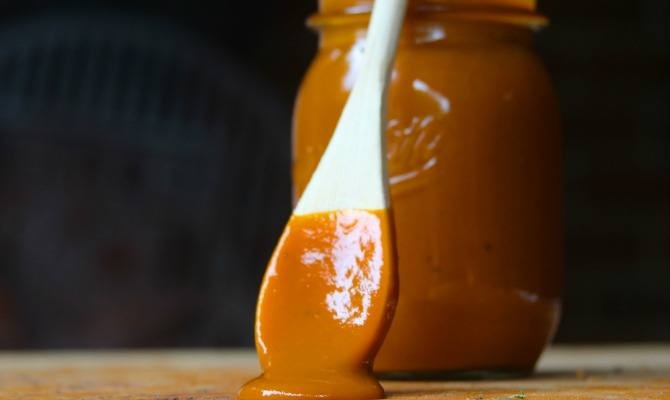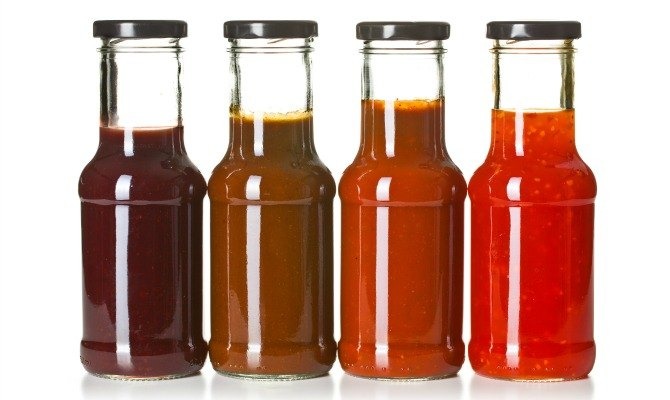Your Guide To Regional Barbecue Sauces
As summer grilling season heats up, so does the demand for barbecue sauce.
But while there are literally thousands of options available today — from mass-market mega-brands to small-batch, independent labels — barbecue sauce in its simplest form can be boiled down to seven regional flavor profiles.
In an effort to educate The Daily Meal readers on these regional sauces, the culinary team at Chef Works, the leading manufacturer and supplier of culinary apparel for chefs and home cooks alike, has created the following Guide to Regional Barbecue Sauces.
REGIONAL BARBECUE SAUCES DEFINED
Kansas City Barbecue Sauce
This is probably the most widely known version of barbeque sauce, with its thick consistency and sweet, slightly tangy flavor profile. While the ingredient list for Kansas City barbecue sauce can exceed 15 different components, it always starts with a tomato or ketchup base and either a brown sugar or molasses sweetener.
Why so is it ubiquitous? Probably because it goes with everything. It is so popular, in fact, that when you see "BBQ flavored" chips or snacks, they're likely inspired by this type of sauce. Because of its high sugar content, it's best used after cooking meat, as it can burn easily over high grilling heat.
South Carolina Mustard Sauce
Arguably the most "love it or leave it" style of regional barbecue sauce, South Carolina's mustard-based version most likely originated during a large immigration of German families to the area in the 1700s. Like many other immigrants, they brought a taste of home with them, but had to adapt to the local cuisine and ingredients. In this case, the mustard they used in many German dishes evolved into a different type of use. Combined with slow-cooked meat, it adds a wonderfully tangy contrast.
West Carolina Vinegar Sauce
Unlike its Southern counterpart, West Carolina barbecue sauce (also known as Piedmont sauce or Lexington sauce) contains no mustard and is the thinnest of all of the regional sauces. A perfect complement to pulled pork or whole hog, this sauce is recognizable by its strong vinegar twang and by the touch of heat provided by chile flakes and cracked black pepper.
St. Louis Barbecue Sauce
You could consider the St. Louis-style barbecue sauce to be a cousin to the Kansas City-style version. Like Kansas City style, it is tomato based, and it has a variety of unique ingredients. The texture is thinner than the Kansas City style, meaning more can be added while the meat cooks.
Texas Mop Sauce Known as a mop sauce since it is often applied with a mop to smoked meats as they cook
, Texas barbeque sauce is thinner in texture than some other barbecue sauces, but it's hearty in flavor, with ingredients such as chile powder, pepper, hot sauce, cumin, and sometimes even meat drippings. The thin texture allows this style of sauce to soak into the meat as it cooks, giving it a rich, full flavor that goes beyond the surface.
Memphis Barbecue Sauce
Here is a sauce that has evolved over the years. Traditionally, in Memphis, the emphasis was less on the sauce and more on the meat, so early versions will be as simple as a mixture of vinegar and pepper. Throughout the years, though, recipes have evolved, and today, you'll often find that a Memphis-style sauce contains tomato and/or brown sugar as well. It retains its identity by maintaining the bite of vinegar, and remains thinner in texture than the Kansas City version.
Alabama Barbecue Sauce
If you go to Alabama, you'll notice something different about the sauce before you even taste it: the color. In Alabama, barbecue sauce is white. The creation of Big Bob Gibson's Bar-B-Q in Decatur, it's a mayonnaise-based sauce that's used to marinate and baste meat, and you'll also see it as a condiment at the table. Alabama seems to be the only place where this white sauce is the rule rather than an exception, and so it's often referred to as "Alabama barbecue sauce" or "Alabama white sauce."


